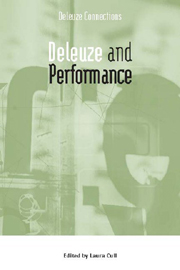Book contents
- Frontmatter
- Contents
- Introduction
- 1 Performing in the Chaosmos: Farts, Follicles, Mathematics and Delirium in Deleuze
- Act I Deleuze on Theatre: Artaud, Beckett and Carmelo Bene
- Interval
- Act II Confronting Deleuze and Live Performance
- Interval
- 10 … of butterflies, bodies and biograms … Affective Spaces in Performativities in the Performance of Madama Butterfly
- Act III A Digital Deleuze: Performance and New Media
- Notes on Contributors
- Index
10 - … of butterflies, bodies and biograms … Affective Spaces in Performativities in the Performance of Madama Butterfly
from Interval
Published online by Cambridge University Press: 12 September 2012
- Frontmatter
- Contents
- Introduction
- 1 Performing in the Chaosmos: Farts, Follicles, Mathematics and Delirium in Deleuze
- Act I Deleuze on Theatre: Artaud, Beckett and Carmelo Bene
- Interval
- Act II Confronting Deleuze and Live Performance
- Interval
- 10 … of butterflies, bodies and biograms … Affective Spaces in Performativities in the Performance of Madama Butterfly
- Act III A Digital Deleuze: Performance and New Media
- Notes on Contributors
- Index
Summary
Through the process of movement, the ‘beautiful’ can be newly discerned as a notion of duration and brain formations. How is the beautiful accommodated through movement and motion? Various forms of motion are more appealing, more alluring, more beautiful to the eye-brain. For example, the pathways of the flight of the butterfly will produce the most invigorating, beautiful and captivating pathways of motion, a cartography of visionary dance across the eye-brain, but also an amorphous fragility within the tactility of the image. The highly variable trajectory of the butterfly will make the brain continually break and form, break and form, breaking any symmetry, thus engaging all three fields of view of the eye. The eternal return of the eye-brain activity (and the butterfly) creates a kinaesthetics, wherein the brain's activities are beyond the merely visual, but become tactile, fluid, in process.
(Kennedy 2000: 116)Within the green fields of Deleuzian grasses the white butterfly's movement captures: aparalletic evolution – the wasp and the orchid.
(Kennedy 2000: 115)The Event/Affect: From Complexity to the Edge of Chaos
For too long the arts and humanities have been haunted by a theoretical impasse which has prioritised the liberal humanist subject, projecting theories of subjectivity, identity, the affective and the aesthetic through recourse to a range of critical theory, such as psychoanalysis, with which to explore the exigencies of the human subjective response to the arts.
- Type
- Chapter
- Information
- Deleuze and Performance , pp. 183 - 200Publisher: Edinburgh University PressPrint publication year: 2009



